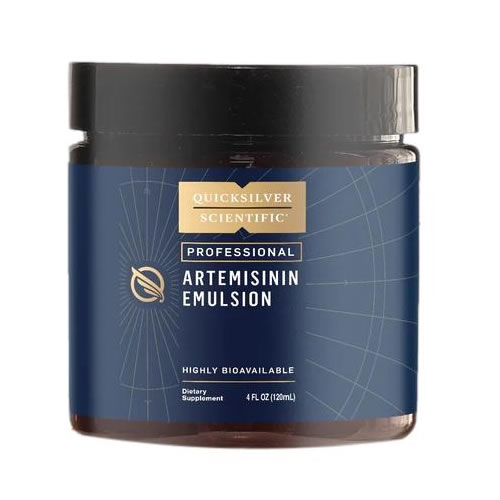Quicksilver Delivery System: Phospholipid Encapsulation
Improved liposomal and emulsification technology with smaller, more stable particles from the highest grade ingredients available.
- Rapid uptake
- Unparalleled bioactivity
- Extended release
- Prolonged effects
Liposomal format absorbs through your lymph system, lessening the burden on your liver - safer for prolonged supplementation.
Artemisinin is a sesquiterpene lactone. Artemisinin and other sesquiterpene lactones have been demonstrated to modulate immune system function and inflammation.
Artemisinin may impact the microbial ecosystem of the digestive system, genitourinary tract, blood, and beyond, as it has been shown to have broad microbial-balancing actions. It also may impact biofilms which make infections such as Candida albicans resistant to treatment.
Traditional artemisinin preparations have a short half-life, and low bioavailability. Liposomal delivery systems have been shown to lead to more stable artemisinin plasma concentrations, suggesting that they lead to an extended release and thereby prolonged systemic effect. The liposomal format absorbs in the lymphatics, which lessens the burden on the liver and makes it a safer alternative for prolonged supplementation.
The phospholipids delivered with artemisinin nourish the membranes of the cells, ensuring proper function for the absorption of nutrients and the excretion of cellular waste products and toxins.
Artemisinin is a sesquiterpene endoperoxide lactone, and the biological mechanism of action may partly be attributable to the generation of free radicals via heme-mediated or mitochondrial-activated degradation of endoperoxidase bridges (1,2). Sesquiterpene lactones are secondary metabolites of plants that play an important role in protecting plants from parasitic invaders, insects, and infection (3). They are bitter compounds, and as such may impact digestion in a manner similar to more commonly used digestive bitters such as gentian.
Artemisinin and its derivatives have been widely studied for their effects against Plasmodium falciparum, the protozoan parasite which causes malaria, and are recommended by the World Health Organization in combination with other therapies as first-line treatment in endemic regions (4,5). Artemisinin may impact the flora of the digestive system, genitourinary tract, and beyond, being shown to have broad microbial balancing actions(6,7). It also may impact biofilms which make infections such as Candida albicans resistant to treatment (8).
Because of the low bioavailability of traditional oral formulations of artemisinin, the use of derivatives such as artesunate (water-soluble) and artemether (oil-soluble) or alternate dosing strategies such as liposomes have been investigated. Liposomal delivery systems have been shown to lead to more stable artemisinin plasma concentrations (9), suggesting that they lead to an extended release and thereby prolonged systemic effect. Additionally, more immediate effects have also been seen with liposomal formulations than conventional artemisinin.
The Quicksilver delivery system brings the power of intravenous therapy into convenient oral delivery, and improves upon liposomal and emulsification technology with smaller, more stable particles made from the highest-grade ingredients available.
In addition to exceptional absorption rates, these very small liposomal and nanoe-mulsified particles enhance lymphatic circulation of nutrients and intracellular delivery (10,11). The phospholipids, inherent in the liposomal and nano-emulsified formats, nourish cell membranes, promoting proper function for the absorption of nutrients and the excretion of cellular waste products and toxins (12).
References
- 1.Meshnick SR. Int J Parasitol. 2002 Dec;32:1655-60.
- Sun C, et al. Microb Cell. 2015;2:14-25.
- Rodriguez E, et al. Phytochemistry. 1976 Jan;15:1573-80.
- White NJ. Science. 2008 Apr;320:330-4.
- WHO guidelines for the treatment of malaria. Geneva: World Health Organization, 2006.
- Bilia AR, et al. Evid Based Complement Alternat Med. 2014;2014:159819.
- Goswami S, et al. Antimicrob Agents Chemother. 2012;56:4594-607.
- De Cremer K, et al. Antimicrob Agents Chemother. 2015 Jan;59(1):421-6.
- Isacchi B, et al. Eur J Pharm Biopharm. 2012 Apr;80:528-34.
- Ahn H, Park JH. Biomater Res. 2016 Nov 23;20:36.
- Alyautdin R, et al. Int J Nanomedicine. 2014 Feb 7;9:795-811
- Spector AA, Yorek MA. J Lipid Res. 1985 Sep;26(9):1015-35


